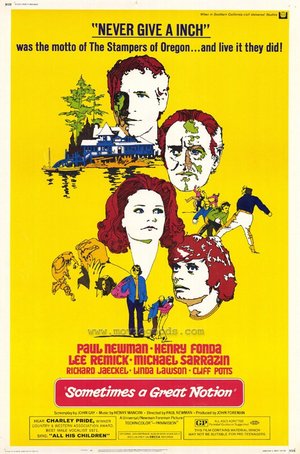My sometimes annual summer stomping grounds on the Central Oregon Coast has a lot of interesting entertainment events that occurred there in its past and unknown to most people. While Hollywood has been there to film some well-known movies in past decades (mostly in Astoria up north)–one particular movie filmed there still resonates today and frequently gets cited by classic movie fans and critics as being undervalued in its time. It’s the 1971 film “Sometimes a Great Notion” (or sometimes known as “Never Give an Inch”) produced, directed by and starring Paul Newman with one of the best classic cast and crew lists you could ask for in any movie (Henry Fonda, Lee Remick and Richard Jaekel co-starring with a slew of good character actors)…let alone in a plot having to do with a strike in the logging industry.
Even though I wasn’t born yet when the movie was filming in Kernville (just outside of my sometimes coastal home away from valley home, Lincoln City)–I still have some familial connections to the film and still occasionally visit the filming site to stare at wonder at the Stamper House (actually an architecturally-interesting house used in the film) that can be seen across the coast’s inland Siletz River. And, yes, this film truly is underrated, timely–though not perfect. It garnered two Oscar nominations for supporting actor and best song…yet Paul Newman so far has refused to release it on a special edition DVD. It needs one to get this curio–and sometimes riveting–film from the last of Hollywood’s true golden age back into people’s minds during a time when labor strikes are a major uncomfortable reality.
The story is based on a Ken Kesey novel (yes, that same Ken Kesey who wrote “One Flew Over the Cuckoo’s Nest”…and “Sometimes” was his follow-up) that tells about an epic union battle within the Oregon logging industry. The Stamper Family is a big family who decide to go against the actions of all other loggers in their small Oregon Coast town (the fictional Wakonda) who are on strike. The Stampers ultimately end up becoming the equivalent of a scab during the strike–yet continue to do their logging without any fear of repercussions. Well, the instigator of it is the patriarch of the Stampers, Henry (played by Henry Fonda in the film) who ultimately ends up creating dissension in his own family by the end. All the events leading up to a tragic ending are an interesting family/romantic/character study and portrait of inner political machinations within the usually complicated and controversial logging industry.
A lot of those who’ve read the original novel (which is considered one of the great American novels today) say that Paul Newman didn’t quite get the story right when it’s truly an epic family tale with differing perspectives and situations. Because the book had most of the characters speaking in first-person–trying to figure out what the motivations of the characters are in the movie might be confusing for those unfamiliar with the plot from the outset. Nevertheless, I’ve seen the film on both commercial and non-commercial TV numerous times (Turner Classic Movies now owns it and shows it once in a purple moon)–and you don’t need to know or care anything about the intricacies of the plot to keep you riveted with the performances in this film. The chemistry with the cast is a lot of fun within a story that’s very much Shakespearean in its mix of witty dialogue and unfortunate tragedy.
Richard Jaeckel as an underrated actor who steals this film away from everybody else…
I’m sure Paul Newman didn’t realize that the actor he personally picked to play his brother in this film would end up overshadowing Newman’s own (yeah, no product placement pun there) performance. Richard Jaeckel was perhaps one of the most undervalued character actors in Hollywood for close to fifty years before his death in 1997. He played all kinds of different roles in his career–but co-starring as Joe Ben Stamper (the younger brother to Newman’s Hank) ended up being his career high with a Best Supporting Actor Oscar nomination for this performance. In the film, Joe Ben more than obviously has a stable marriage (one brief and comically implied sex scene in the family bathroom proves that) compared to his troubled older brother. Hank has marital problems with his wife, Viv. She’s played by the beautiful and unfortunately late Lee Remick in the film whose unreal blue eyes are just as glowing here as they were in all her previous classic films done in color. In turn, Viv has a brief affair later in the film with Hank’s other younger brother, Leeland–who’s more or less a drifter suddenly showing up at the family home after being away. Leeland is played by well-known character actor Michael Serrazin.
As good as all those performances are–Jaeckel still stood out in just about every scene he was in. That’s unusual, too, because he’s not a villain here (as he usually played in other movies), but actually a good-natured guy who provides a lot of the film’s funniest lines in his interactions with Hank and the family. Most people would probably agree, though, that Jaeckel’s Oscar nomination came from one of the final scenes in the movie: Joe Ben tragically drowns during a logging accident as Hank struggles desperately to save his brother.
This scene gets cited often as one of the most dramatic scenes in movie history. Without giving away too much detail in this harrowing scene–it involves a giant log falling into the river…ultimately pinning Joe Ben in a situation that looks fixable, but ends up not due to the shifting currents in the water.
It’s amazing that Richard Jaeckel managed to be funny during such a tragic death scene–and you’ll laugh at his lines before your jaw hits the floor at the end result. The whole scene is done so realistically, too, that you’d swear it was real. It’s just too bad Richard Jaeckel couldn’t have had roles that were this good after “Sometimes a Great Notion” was made. He worked for 23 more years in various movies and TV series (playing Lt. Ben Edwards in “Baywatch” was his last role in the early 90’s)–though never really had as dramatic or appealing a performance as he had in this film. Unfortunately, he didn’t win the Supporting Actor Oscar and lost to Ben Johnson in “The Last Picture Show” at the 1972 Oscar telecast. Richard Jaeckel was a quite a nice guy in real life, however–and I can attest to that via my grandparents who met him along the Siletz River as the movie was being shot in 1970.
Personal connections to the film…
I’ve long had an interesting connection to the area of Kernville and vicinity where “Sometimes a Great Notion” was filmed. Without wanting to veer away too much from talking about the film–my grandparents were fairly well-known for vacationing in the Kernville area every summer and on record of catching the biggest salmon ever caught in the Siletz River (up to that time anyway). I have photographic proof of that giant salmon they caught that was close to six or seven feet long. And the word got around the area about that story, though it was likely unknown to the cast and crew filming nearby when my grandparents happened to be staying in the area and fishing the river again that summer.
According to the stories I heard when younger–my grandparents were out fishing along the Siletz one afternoon and passed a young, blond-haired guy alone in a boat who also was fishing. That person happened to be Richard Jaeckel who apparently decided to do most of his recreation in the area when filming was stalled. I actually heard most of the cast and crew lived on site in a campground area not far away from the famous house used in the film. My grandparents struck up a nice little friendship with Jaeckel that day, talked quite a bit as they fished and eventually were invited to attend a filming of a scene that would be done outside the Stamper House not far up around the bend of the river.
While my grandparents weren’t used as extras in the film (though many who lived year-round in the area had been hired to)–the invitation gave them the opportunity to watch a particular night scene being shot outside the house. The crew asked everybody to sit on the ground and (as you might guess) stay quiet as they watched from the sidelines. I think I know which scene that is if you’ve ever seen the film–because it’s the only scene shot at night outside the home. Henry Fonda and just about all the cast members are in the scene, incidentally.
After I was born later, my parents and I would frequently join my grandparents and vacation in the area, and I pretty much created my emotional connection to the surroundings that still goes on. The stories of the filming done there and my grandparents being close to it only add to the mystique of a natural environment that already has an appealing mystique that draws you back if you ever visit the area for the first time. You can see what I mean if you witness the aerial shots done around the house for the film.
When I visit the coast now–I don’t stay right in that area, but can’t resist driving the long, narrow and winding road (just off Hwy. 101) along the Siletz River to see the awe-inspiring scenery and house across the river where the film was mostly filmed. When I hear stories of Paul Newman, Henry Fonda and Lee Remick hanging out in (and filming in) all the places I’ve been in my lifetime along that stretch of coast–it brings a part of classic Hollywood folklore to the area. The movie’s scene with the motorcycle beach race and fistfight was filmed at Fogarty Beach where I’ve been many times and just up 101 from Kernville.
Paul Newman should release the film on DVD as a retirement project…
This film apparently didn’t do well at the box office when released in 1971. Because Paul Newman likely considers that one of his personal feature production failures (despite months of hard work and personal research by him for the film)–he probably figures nobody would care today about a special edition DVD of “Sometimes a Great Notion.” But I see comments all the time on the net for this film that rave about it and say that it’s one of the most underrated American films of the last forty years. Because I have more of a different frame of mind on the film–I seem to exclude myself from giving a true outside-the-box analysis of the film itself. It’s hard to guess if the average viewer would really care about the plot. Nevertheless, the plot is still timely in detailing the mechanics of labor strikes and the dangers of crossing the lines for your own pocketbook. The classic actors here, though, are so magnetic that you’ll still love the film…along with the usually funny dialogue.
While it may have lost some luster recently–it sustained a lot of buzz throughout the 70’s and 80’s. You may or may not be aware that it was the first movie shown on HBO when the fledgling cable service first went on the air in 1972. It also received a lot of airplay (albeit butchered prints) on local TV stations through the late 70’s and well into the 80’s. As I said earlier, TCM owns it currently–yet barely shows it. And the only home media release it had was a VHS tape version released back in the late 80’s with nothing that even resembled an extra (when that just received a “Huh?” reaction in that decade).
A lot of retired legendary stars turned directors/producers frequently ignore any critical or box office failures they have in their film canon as a way to preserve the quality of their acting and film legacy. That might seem egotistical when those ignored films do have fanbases that could make a two-disc special edition DVD successful enough to turn a profit. Maybe Paul Newman (now that he’s said to be retired from acting forever) will soon take the time to assemble a DVD edition of this film…considering his generous nature all the way around. A DVD release of it would definitely generate buzz and interest. And he should include plenty of extras that I know he likely has stored away somewhere–including recording his own director commentary before it’s too late and he gets too old to do it. He should also have a feature on the composer for the soundtrack. That second Oscar nomination for the film went to Henry Mancini for a song he wrote for the film: “All His Children.” It’s sung by legendary country music artist Charley Pride during the opening and end credits.
Paul Newman may want to declare his spaghetti sauce, popcorn and salad dressing as his “own”–but this film is definitely an interesting and still timely part of his film legacy that should be given his own respect.




